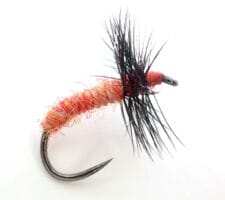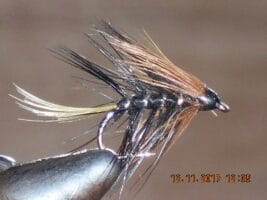Your cart is currently empty!
Idaho Killer Kebari Fly
Introducing the Idaho Killer Kebari Fly, a renowned Japanese tenkara fly pattern celebrated for its effectiveness. Crafted with a reverse-hackle design, this fly boasts lifelike movements that attract various fish species. Anglers seeking a proven and versatile fly pattern should consider adding the Idaho Killer Kebari to their collection. With our expert fly tiers, we…
Description
Historical Significance and Pattern Evolution
The Idaho Killer Kebari fly represents a Western adaptation of traditional Japanese Tenkara flies, specifically designed for American trout waters. This innovative pattern combines traditional Kebari tying techniques with modern materials and design elements. Originally developed for Tenkara fishing, this pattern has gained popularity due to its versatility and effectiveness across various fishing conditions, making it a staple pattern for both traditional Tenkara anglers and western fly fishers.
Premium Materials and Construction Details
Essential Materials List:
- Hook: Size 12 nymph hook (barbless preferred)
- Thread: Black or brown 8/0
- Body: Jamieson’s Shetland Spindrift Flame yarn
- Hackle: Size 12 dry fly hackle (reverse-tied)
- Thorax: Darker dubbing
- Optional: Wire rib
- Head: Thread with clear finish
- Optional: Peacock herl thorax
- Optional: CDC enhancement
- Optional: Wire weight
Material Selection Considerations:
- Hook strength matches fishing style
- Thread strength crucial for durability
- Body yarn creates proper profile
- Hackle quality determines action
- Thorax material adds bulk
- Rib adds segmentation
- Head finish protects materials
- Material preparation affects profile
- Storage conditions preserve materials
- Color selection matches conditions
Detailed Tying Instructions
Preparation Steps:
- Select appropriate hook size
- Choose quality hackle
- Prepare body yarn
- Select thread color
- Organize workspace
- Check tools
- Plan proportions
- Review pattern
- Test thread strength
- Prepare materials
Step-by-Step Tying Sequence:
- Start thread behind eye
- Create uniform thread base
- Tie in optional rib
- Form yarn body
- Add ribbing if desired
- Tie in reverse hackle
- Build thorax
- Wind hackle forward
- Form neat head
- Whip finish
- Apply head cement
- Check proportions
Advanced Fishing Techniques
Presentation Methods:
- Traditional Tenkara drift
- Pulsing retrieve
- Dead drift
- Swing presentation
- Downstream presentation
- Surface film fishing
- Deep presentation
- Current seam fishing
- Structure approaches
- Pattern combinations
Water Reading Skills:
- Identify feeding lanes
- Recognize current breaks
- Spot rising fish
- Detect subsurface activity
- Read water clarity
- Locate prime lies
- Find transition zones
- Identify temperature breaks
- Track fish movement
- Monitor insect activity
Seasonal Strategies
Spring Tactics:
- Match early hatches
- Focus on warming water
- Target active fish
- Adjust presentation
- Monitor temperatures
- Watch for rises
- Follow fish movement
- Time presentations
- Adapt to conditions
- Match natural drift
Summer Applications:
- Early morning fishing
- Late evening sessions
- Target shade lines
- Focus on riffles
- Match daily patterns
- Observe feeding windows
- Adjust to conditions
- Monitor water levels
- Watch temperatures
- Time presentations
Fall Approaches:
- Match late-season hatches
- Target feeding fish
- Adjust presentation style
- Watch water conditions
- Monitor temperatures
- Follow movement patterns
- Adapt to weather
- Time efforts effectively
- Match natural drift
- Adjust techniques
Technical Rigging Considerations
Leader Construction:
- Traditional Tenkara line
- Level line options
- Proper diameter selection
- Breaking strength considerations
- Length adjustments
- Material choices
- Knot selection
- Visibility factors
- Sink rate control
- Setup variations
Terminal Tackle:
- Direct connection methods
- Tippet selection
- Line control
- Strike detection
- Depth adjustment
- Pattern spacing
- Drift control
- Presentation angles
- Setup modifications
- Tippet length
Habitat-Specific Tactics
Water Types:
- Mountain streams
- Spring creeks
- Tailwaters
- Small brooks
- Large rivers
- Mixed waters
- Clear streams
- Pocket water
- Riffles
- Pools
Specific Locations:
- Feeding lanes
- Current seams
- Structure edges
- Bank water
- Mid-stream
- Transitions
- Drop-offs
- Shallow flats
- Deep runs
- Protected areas
Advanced Presentation Methods
Traditional Techniques:
- Upstream presentation
- Downstream presentation
- Cross-current drift
- Pulsing action
- Dead drift
- Swing presentation
- Surface film
- Structure approach
- Bank presentation
- Depth control
Modern Adaptations:
- Western-style drifts
- Multiple fly rigs
- Indicator techniques
- Edge water tactics
- Structure approaches
- Pattern combinations
- Presentation modifications
- Depth control
- Speed variations
- Drift management
Pattern Variations
Size Considerations:
- Match natural insects
- Consider water type
- Adapt to pressure
- Account for clarity
- Follow seasonal trends
- Consider fish size
- Match preferences
- Adapt to conditions
- Consider speed
- Match forage base
Style Variations:
- Traditional reverse hackle
- Forward hackle
- CDC enhanced
- Weighted version
- Unweighted pattern
- Thorax variations
- Body material options
- Color variations
- Hackle options
- Seasonal patterns
The Idaho Killer Kebari represents the perfect fusion of traditional Japanese design and modern American innovation. Its carefully selected materials and precise construction ensure consistent performance across various fishing conditions. Whether fishing traditional Tenkara style or adapting it to western techniques, this pattern provides the perfect tool for successful fishing throughout the season.
Additional information
| Hook size | 10, 12, 14, 16, 18, 20, 22 |
|---|---|
| Hook type | Barbed Hooks, Barbless Hooks |







